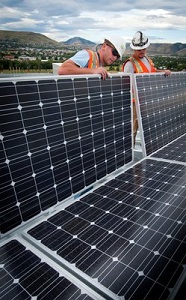Reviewing last week's solar energy news
 With the current market instability, the future for just about everything is choppy—except for sending kids back to school and, increasingly, the maturation of solar. Nothing said this more than news that firms continued to invest in solar. Whether funding further project development or buying into companies, it happened last week, showing that companies continue to see solar as a better bet.
With the current market instability, the future for just about everything is choppy—except for sending kids back to school and, increasingly, the maturation of solar. Nothing said this more than news that firms continued to invest in solar. Whether funding further project development or buying into companies, it happened last week, showing that companies continue to see solar as a better bet.
The biggest deal last week was Colorado-based Ascent Solar’s (NASDAQ: ASTI) $450 million strategic agreement with China-based TFG Radiant Group. Under the agreement TFG Radiant will license Ascent’s flexible thin-film photovoltaic technologies, paying royalties to the company. And TFG Radiant will build a 100-megawatt annual capacity production plant to produce modules with Ascent technology in East Asia.
Other companies increased their stake in solar last week as well. For instance, Citigroup (NYSE: C) launched a new, $50 million fund to support new Sungevity solar leases for homeowners. The fund is a renewable energy tax equity fund that will largely support Sungevity's expansion in eastern U.S. states and through its partnership with Lowes.
Meanwhile General Electric (NYSE: GE) increased its numerous investments in solar with a $20 million—potentially $40 million—minority stake in eSolar. GE previously chose to use eSolar’s modular solar thermal tower technology in its first Integrated Solar Combined Cycle power plant, which will be developed in Turkey. Under the agreement GE will license eSolar’s technology for deployment throughout most of the world.
While Ford didn’t buy into a solar company last week, it did partner with SunPower Corp. to offer home-owning buyers of its forthcoming electric Ford Focus a discounted 2.5 kilowatt photovoltaic array for their home. Under the partnership, owners’ of Ford’s electric vehicles can get the array with an average price of less than $10,000.
The news wasn’t limited to investments and partnerships, however. The gigantic solar farms of tomorrow finally starting to break ground as their developers rush to meet deadlines for federal incentives. Desert Sunlight Holdings, a First Solar subsidiary, received final approval from Department of Interior Secretary Ken Salazar for the 550-megawatt Desert Sunlight project, allowing construction on the project to start.
Another gigantic project involving First Solar is the 290-megawatt Agua Caliente Solar Project being developed by NRG Energy, Inc. Progress on that project took two significant leaps forward when the DOE finalized its $976 million loan guarantee for the project, which led NRG Energy to complete its purchase of the project from First Solar.
That doesn’t mean all these large-scale solar projects have cleared all the hurdles they need to move forward. Two California conservation organizations, North County Watch and Carrizo Commons sued last week to stop development of the 550-megawatt Topaz Solar Farm—also being developed First Solar. The suit comes after national conservation organizations agreed not to sue over the project. The local activists think that the environmental analysis for the project was rushed through.
This summer’s seen a lot of solar campaigns and contests. Not to be outdone, Dow Chemical company last week launched the Dow Solar Design to Zero Competition. Under the competition, classes, students and professionals in architecture, design and engineering are challenged to design the next generation of energy-efficient, solar homes. The top prize is $20,000.
Boulder, Colo., made the news last week when the nouveau-hippy town cut the ribbon on a combined installation that included solar thermal, photovoltaics and an electric-vehicle charging station connected to the photovoltaic array. But that’s just one part of the city’s much larger, 66-building Energy Performance Contract, which will cost the city roughly $12 million but save it about $500,000 annually.
Image courtesy of NREL.



